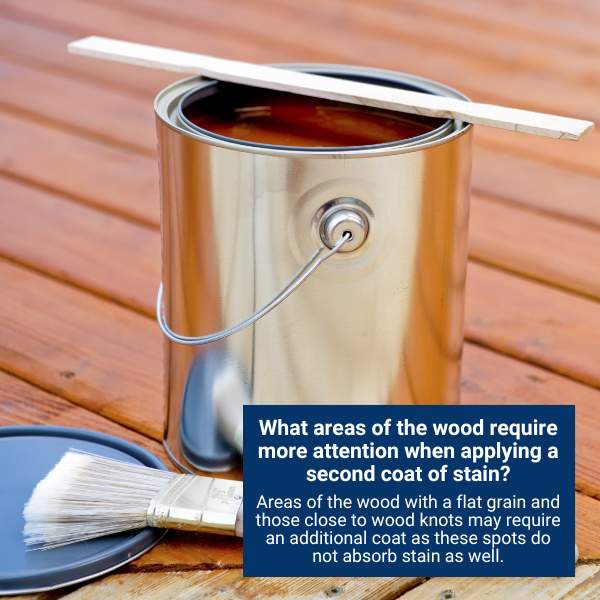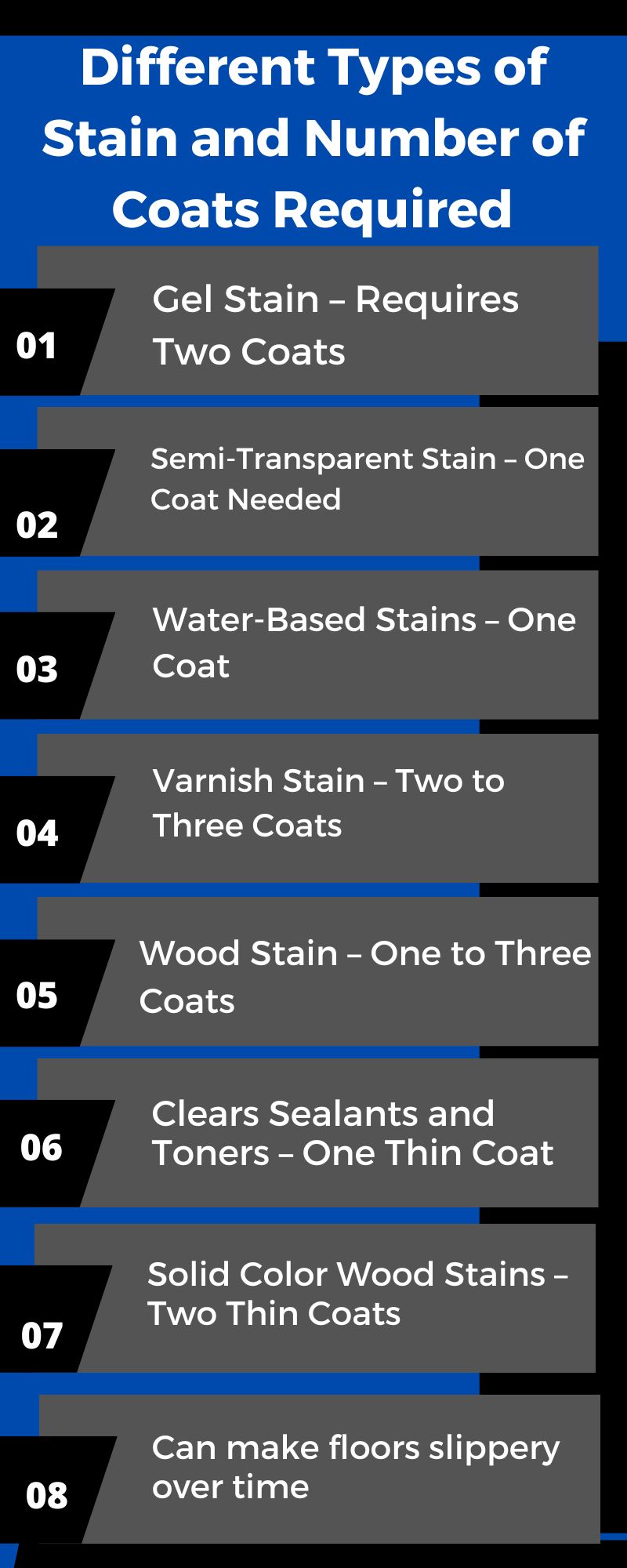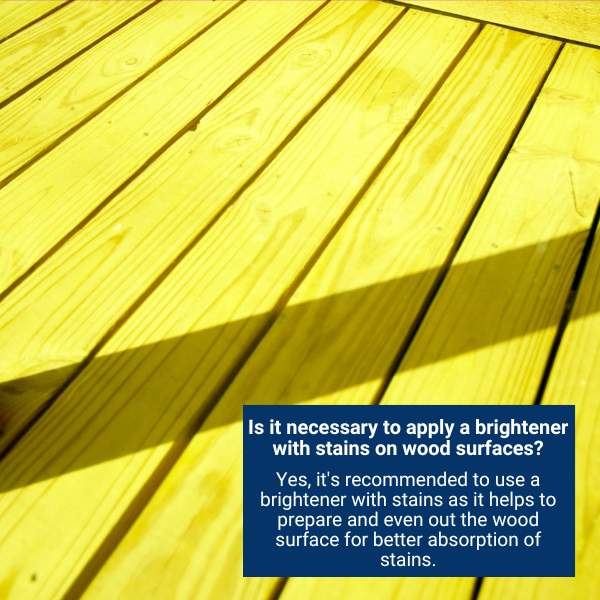Are you concerned that your external wooden decking isn’t adequately protected to last through the changing seasons? Unsure of how many coats of stain are necessary for optimal coverage and protection from the elements?
It is a common query among homeowners, so how much stain should be used to ensure maximum defense without making its texture patchy or uneven?
Apply two coats of stain on a deck. It may require more than two coats depending on the type of product used, the age of the wood, and the desired level of protection. Follow the manufacturer’s instructions for optimum results, as some stains require a brightener and an additional coat for optimum durability.
In this expert guide, I’ll show you exactly how many coats of stain you need for your deck and all the information and guidance needed to ensure a stunning, resilient finish!

How Many Coats Of Stain Should You Use On A Deck? A Definitive Guide!
Numerous elements must be taken into account when choosing an appropriate number of coats.
Depending on the staining product you use, it’s important to always read and follow the manufacturer’s directions. Pay attention to details like the right number of coats, waiting periods between each coat, and how long after preparing the wood before staining.
Even if you have experience with stain products, make sure to read over any new instructions carefully prior to use.
Additionally, staining wood requires careful research about the type of deck surface you’ll be using to determine how many coats of stain will be necessary.
For example, hardwood typically only needs one coat since it’s harder than other woods; however, softer varieties such as oak require two to three coats due to their ability to absorb more and need added protection from wear over time.
The first layer penetrates into the grain, while the remaining layers are applied for the desired coloration.
Generally speaking, two coats of stain should be enough to adequately cover a deck since its hard surface does not need as much absorption. However, on older decks, you may need multiple coats of stain to ensure the wood is fully protected.
If the wood is clean, it should readily accept the first coat of stain. A second light layer can then help fill up the cell structure for extended protection against weathering damage.

Different Types Of Stain And How Many Coats Are Needed For Optimal Results
Here is a brief overview of the most popular types of stain and how many coats they typically require:
- Gel Stain – For this type of stain, two coats are essential for optimal coverage. Each layer adds to the depth and intensity of your project’s color; begin with a lighter shade and gradually increase darkness as desired.
- Semi-Transparent Stain – When it comes to semi-transparent stains, one coat is required. This type of stain allows the wood’s natural grain to show through and lets the wood breathe, which means that over-applying can lead to peeling off over time.
- Water-Based Stains – Water-based staining products are now better than conventional oil-based products due to improvements in manufacturing processes and quality regulations. They are safer to work with since they do not contain pungent solvents, don’t require the wood to be fully dry before application, have a shorter drying time, and are more resistant to weathering.
- Varnish Stain – To ensure ultimate protection and longevity, it is recommended to apply two or three coats of varnish stain on your surfaces; the higher the traffic, the more layers are required. Specifically speaking, those surfaces that receive low foot traffic should be given two coats, while areas with high levels of activity require a triple coating.
- Wood Stain – Depending on your desired goal – either changing the hue of the wood grain or providing full coverage – one to three coats are necessary.
- Clears sealants and Toners – These products require the application of one thin coat for optimal protection. This is because they are designed to penetrate deep into the wood, sealing it from within.
- Solid Color Wood Stains – For these products, two thin coats should be applied for optimum durability and coverage, as this will hide wood grain and imperfections.
- Lacquer Stain – A minimum of three coats of lacquer stain is essential to ensure an adequate layer and protection. Unfortunately, it’s a too-thin finish for vertical surfaces since its viscosity can cause droplets to drizzle off.

Additional Rules For Applying Coats Of Stain On A Deck
To ensure the best possible results when staining your wood surfaces, consider these essential factors:
1. Do Not Opt For Inferior Products
Cheap products often don’t perform as well, so it’s worth investing in higher-quality stains to get the best results.
2. Apply One Coat On Top Of Another While Wet
When using waterborne products, make sure to apply a wet coat on top of another while still wet – allowing the product to dry out between coats can have negative effects as waxes and paraffin will repel the material, causing it to lay on the surface and eventually peel off.
3. Include A Brightener In Your Process
A brightener can dramatically improve the performance of your stain. This step is often overlooked, but it’s easy to include – simply spray the product on and wait for about 10 minutes before rinsing it off with a hose or power washer.
Brighteners open up wood pores, neutralize any stripping materials used, and rejuvenate older wood to make it look like new.
4. Utilize Some Sort Of Brush For Applying
Whether using a sprayer or simply applying by brush, use some sort of brush to work the stain into the wood. Brushes even out the material, and the friction helps open up wood pores. Failing to do so can result in peeling and poor results.
Consider using a paintbrush, as this allows you to push deep into the wood for maximum penetration.

How Many Coats Of Stain On A Deck: Key Points!
Here are some vital tips to keep in mind when applying multiple coats of stains:
1. Make sure the first coat is completely dry before applying a second coat–at least 6-12 hours of dry time or until there is no tackiness whatsoever.
2. When applying a second coat, use the same process as before to ensure even coverage and proper protection.
3. If there is no sheen evident after the second coat, it may be necessary to apply a third coat as older decks can be very dry and porous.
4. Areas of the wood with flat grain may require an additional coating as these spots do not absorb stain as well as vertical grain.
5. Areas close to wood knots may not absorb many colors, so these spots may need more attention when applying the second coat.

Conclusion
To ensure your wooden deck looks stunning for years to come, it’s important that you apply just the right amount of stain. Too much or too little could be disastrous; however, with some extra attention and effort, you can guarantee a lovely finish! To get started on this project, make sure to follow the above best practices and suggestions carefully.

